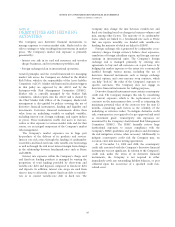American Express 2009 Annual Report Download - page 100
Download and view the complete annual report
Please find page 100 of the 2009 American Express annual report below. You can navigate through the pages in the report by either clicking on the pages listed below, or by using the keyword search tool below to find specific information within the annual report.NOTES TO CONSOLIDATED FINANCIAL STATEMENTS
AMERICAN EXPRESS COMPANY
NOTE 12
DERIVATIVES AND HEDGING
ACTIVITIES
The Company uses derivative financial instruments to
manage exposure to various market risks. Market risk is the
risk to earnings or value resulting from movements in market
prices. The Company’s market risk exposure is primarily
generated by:
폷Interest rate risk in its card and insurance and travelers
cheque businesses, and its investment portfolios; and
폷Foreign exchange risk in its international operations.
General principles and the overall framework for managing
market risk across the Company are defined in the Market
Risk Policy, which is the responsibility of the Asset-Liability
Committee (ALCO). Market risk limits and escalation triggers
in that policy are approved by the ALCO and by the
Enterprise-wide Risk Management Committee (ERMC).
Market risk is centrally managed by the Market Risk
Committee, which reports into the ALCO and is chaired by
the Chief Market Risk Officer of the Company. Market risk
management is also guided by policies covering the use of
derivative financial instruments, funding and liquidity and
investments. Derivative financial instruments derive their
value from an underlying variable or multiple variables,
including interest rate, foreign exchange, and equity indices
or prices. These instruments enable end users to increase,
reduce or alter exposure to various market risks and, for that
reason, are an integral component of the Company’s market
risk management.
The Company’s market exposures are in large part
by-products of the delivery of its products and services.
Interest rate risk arises through the funding of cardmember
receivables and fixed-rate loans with variable-rate borrowings
as well as through the risk to net interest margin from changes
in the relationship between benchmark rates such as Prime
and LIBOR.
Interest rate exposure within the Company’s charge card
and fixed-rate lending products is managed by varying the
proportion of total funding provided by short-term and
variable-rate debt and deposits compared to fixed-rate debt
and deposits. In addition, interest rate swaps are used from
time to time to effectively convert fixed-rate debt to variable-
rate or to convert variable-rate debt to fixed rate. The
Company may change the mix between variable-rate and
fixed-rate funding based on changes in business volumes and
mix, among other factors. The majority of its cardmember
loans, which are linked to a benchmark rate such as Prime
that can reprice monthly, are funded with variable-rate
funding, the majority of which are linked to LIBOR.
Foreign exchange risk is generated by cardmember cross-
currency charges, foreign currency balance sheet exposures,
translation of foreign subsidiary equity, and foreign currency
earnings in international units. The Company’s foreign
exchange risk is managed primarily by entering into
agreements to buy and sell currencies on a spot basis or by
hedging this market exposure to the extent it is economically
justified through various means, including the use of
derivative financial instruments such as foreign exchange
forward, options, and cross-currency swap contracts, which
can help “lock in” the value of the Company’s exposure to
specific currencies. The Company does not engage in
derivative financial instruments for trading purposes.
Derivative financial instruments may contain counterparty
credit risk. The Company manages this risk by considering
the current exposure, which is the replacement cost of
contracts on the measurement date, as well as estimating the
maximum potential value of the contracts over the next 12
months, considering such factors as the volatility of the
underlying or reference index. To mitigate derivative credit
risk, counterparties are required to be pre-approved and rated
as investment grade. Counterparty risk exposures are
monitored by the Company’s Institutional Risk Management
Committee (IRMC). The IRMC formally reviews large
institutional exposures to ensure compliance with the
Company’s ERMC guidelines and procedures and determines
the risk mitigation actions, when necessary. Additionally, to
mitigate counterparty credit risk the Company may, on
occasion, enter into master netting agreements.
As of December 31, 2009 and 2008, the counterparty
credit risk associated with the Company’s derivative financial
instruments was not significant. In relation to the Company’s
credit risk, under the terms of its derivative financial
instruments, the Company is not required to either
immediately settle any outstanding liability balances, or post
collateral upon the occurrence of a specified credit risk-
related event.
98
























